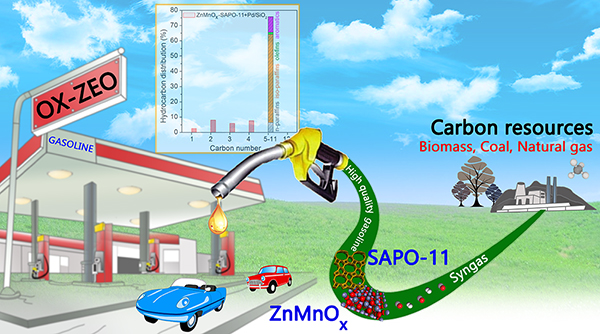Recently, the research team led by Profs. Xiulian Pan and Xinhe Bao from the Dalian Institute of Chemical Physics (DICP) of the Chinese Academy of Sciences (CAS) achieved direct synthesis of high-quality gasoline from syngas, which was just published in Angewandte Chemie-International Edition (DOI: 10.1002/anie.201902990).

Syngas is an important intermediate platform for efficient utilization of carbon resources such as coal, natural gas and biomass, which can be converted to a variety of chemicals and fuels. However, precise control C-C coupling to fabricate desired products remains a challenge in syngas chemistry.
The OX-ZEO (Oxide-Zeolite) catalyst design concept, which was reported by this research team, has enabled selective syngas conversion to mixed light olefins with a high selectivity of 80% among hydrocarbons (Science 351 (2016) 1065-1068; ACS Catalysis 7 (2017) 2800-2804; ACS Catalysis 9(2019) 960-966), to ethylene with a selectivity of 83% (Angew. Chem. Int. Ed. 57(2018) 4692-4696) and to aromatics of 73.9% (Chemical Communications 53 (2017) 11146-11149; Journal of Energy Chemistry 35 (2019) 44–48), far beyond the limits predicted by the ASF distribution model.
This study reports one step transformation of syngas to gasoline with a selectivity of 77% at CO conversion of 20%. The hazardous aromatics content in gasoline (< 16%) was significantly lower than the limits set by most countries. The ratio of isoparaffins to n-paraffins was as high as 15, giving a research octane number of 92 in contrast to about 35~43 obtained by the conventional low temperature Fischer-Tropsch synthesis.
This provides a potential technology for one-step synthesis of high quality gasoline from a variety of carbon resources via syngas. It demonstrates again that the OX-ZEO catalyst concept is general and may be applicable for synthesis of other chemicals from syngas.
This work was supported by the Ministry of Science and Technology of China, the Chinese Academy of Sciences and the National Natural Science Foundation of China. (Text by Li Na; Image by Jiao Feng)